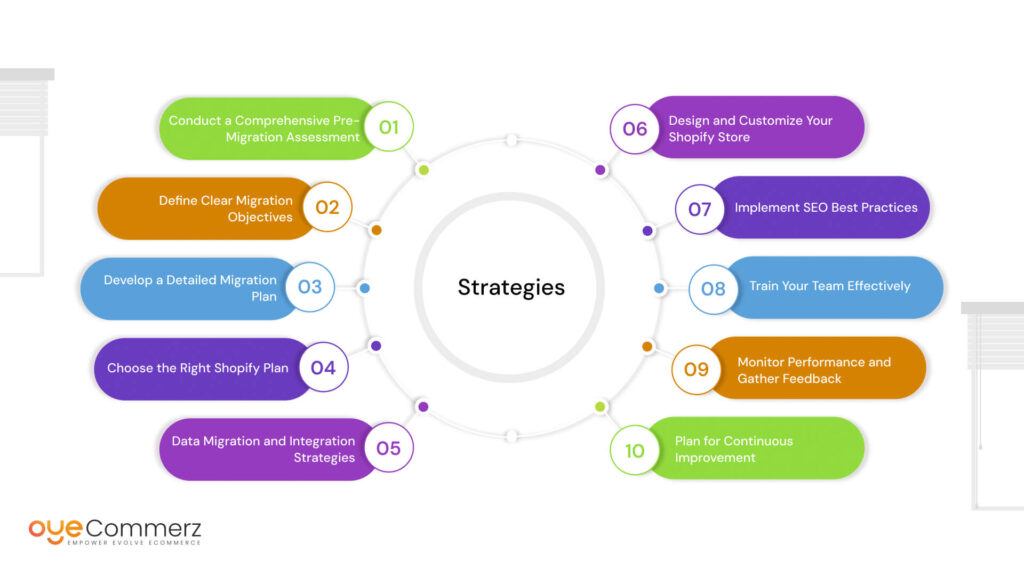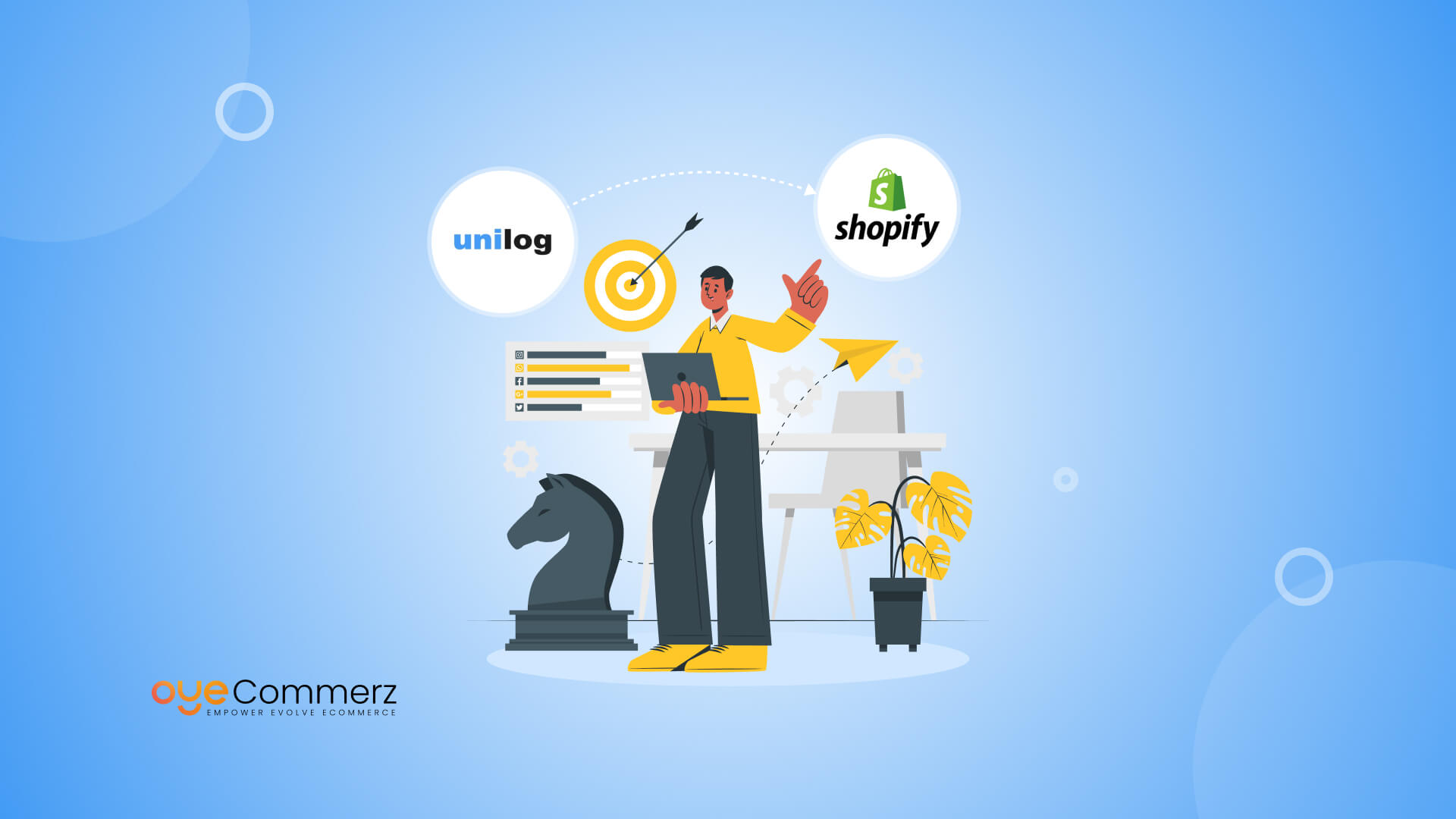Are you a existing business owner feeling stuck with the limitations of Unilog? You’re not alone – many e-commerce businesses outgrow their platforms and face the tough decision of migrating to a more flexible solution like Shopify. Unilog to Shopify migration might seem difficult, but it’s a game-changer. In fact, 60% of businesses that make the switch experience a significant boost in performance and customer satisfaction. This blog will walk you through proven strategies for migration , ensuring that your store is ready to scale and thrive on Shopify. Let’s go and set you up for success!
Table of Contents
ToggleWhy Strategies Are Important in Migration?
Migration from one eCommerce platform to another is a critical process that directly impacts your business’s operations, customer experience, and overall growth. A well-structured migration strategy is not just a helpful guide; it’s essential to ensure the transition is successful. Without a solid strategy, businesses may encounter various obstacles that can result in data loss, decreased sales, or a negative customer experience. Here’s why having a clear and comprehensive strategy is so important:
1. Ensures Seamless Transition with Minimal Downtime
Migrating your eCommerce store involves a variety of technical tasks, from data migration to theme customization. If not executed with care, these tasks can lead to unexpected downtime, disrupting your store’s availability. This could cause frustration for customers, lost revenue, and a negative impact on your brand’s reputation. A well-thought-out migration strategy helps ensure a smooth transition, reducing the risk of downtime and ensuring that your store remains operational throughout the process.
2. Protects Data Integrity and Accuracy
One of the biggest concerns during a migration is maintaining the integrity of critical data, such as customer details, order histories, inventory, and product information. Without a defined strategy, there is a risk of data corruption or loss, which could disrupt your business operations. By having a strategy in place, businesses can carefully plan how to handle data transfers, ensuring that all data is accurately mapped and transferred to the new platform, and that no valuable information is lost in the process.
3. Safeguards SEO Rankings
SEO plays a crucial role in your store’s visibility and traffic. During migration, if URLs, meta descriptions, product pages, or other important SEO elements aren’t handled correctly, you risk losing search engine rankings and traffic. A migration strategy helps preserve your SEO efforts by ensuring that proper 301 redirects are set up, metadata is correctly transferred, and your site structure is optimized for search engines. This ensures that your site maintains its search ranking and visibility post-migration, preserving the organic traffic that you’ve worked hard to build.
4. Prevents Loss of Revenue
If the migration process isn’t carefully managed, it can lead to errors in product availability, pricing, checkout issues, and payment gateway integration. These errors can directly result in lost sales, abandoned carts, and frustrated customers. A strategic approach ensures that all features, from product catalogs to the checkout process, are properly tested and optimized before the migration is complete. By focusing on the details and identifying potential issues beforehand, businesses can avoid revenue loss and ensure a smooth shopping experience for customers.
5. Improves User Experience
A smooth migration isn’t just about technical processes; it’s also about providing a seamless experience for your customers. The user experience (UX) on your new Shopify store should be intuitive, fast, and easy to navigate. A well-planned migration strategy includes ensuring that the design and UX of the new store are optimized for customer satisfaction. From ensuring mobile optimization to streamlining the checkout process, a migration strategy places a strong emphasis on keeping the user experience at the forefront, leading to higher conversions and customer retention.
6. Optimizes Post-Migration Operations
A successful migration strategy doesn’t end with the switch to Shopify. Once the store is live, businesses must monitor performance, ensure functionality, and address any remaining issues. A well-executed strategy includes post-migration testing, gathering customer feedback, and ensuring that all integrations and features are working as expected. This helps businesses quickly adapt and make any necessary improvements after the migration to ensure long-term success.
7. Supports Long-Term Growth and Scalability
One of the main reasons businesses migrate to Shopify is to unlock better scalability and growth potential. A solid migration strategy sets up your store for success not only during the transition but for the future. It involves planning for future needs such as integrations, app usage, and customization to support business expansion. By focusing on long-term goals during migration, businesses can ensure that their Shopify store is ready to grow and scale with ease.
Let’s explore these migration strategies in detail

1. Conduct a Comprehensive Pre-Migration Assessment
A successful migration begins long before any data is transferred. Performing a comprehensive pre-migration evaluation is crucial for gaining insights into your existing setup and laying the groundwork for a smooth transition.
Key Components to Analyze
- Infrastructure Assessment: Evaluate your existing Unilog setup, including server performance, load times, and user traffic patterns.
- Data Integrity Audit: Identify any duplicates, inaccuracies, or outdated information in your current dataset. Ensuring data integrity is crucial for a successful transfer to Shopify.
- Feature Requirements Evaluation: List the essential features and functionalities you currently utilize. This will guide your Shopify setup and ensure that critical capabilities are retained or improved.
By gaining a clear understanding of your existing system, you can develop a tailored migration plan that addresses specific business needs.
2. Define Clear Migration Objectives
Setting clear objectives is vital for maintaining focus throughout the migration process. Establishing these goals will help your team align their efforts and measure success post-migration.
Common Migration Objectives
- Sales Growth Targets: Define specific revenue goals you aim to achieve within a set timeframe post-migration.
- User Experience Enhancements: Identify key metrics to improve, such as site navigation, page load speed, and customer satisfaction scores.
- Operational Efficiency Improvements: Set benchmarks for improvements in order processing times, inventory management, and customer service response times.
Clear objectives will not only guide your migration efforts but also provide a framework for assessing the success of your transition.
3. Develop a Detailed Migration Plan
A well-structured migration plan serves as a roadmap for your transition. This approach helps reduce risks and possible interruptions, ensuring that all team members are coordinated during the process.
Essential Elements of Your Migration Plan
- Timeline with Key Milestones: Outline significant phases of the migration, including assessments, data transfer, testing, and launch dates.
- Resource Allocation: Identify the team members responsible for each phase and any external resources you may need, such as consultants or technical support.
- Risk Management Strategies: Develop contingency plans for potential issues, ensuring your team is prepared for unforeseen challenges.
By creating a comprehensive migration plan, you can facilitate smoother transitions and keep your project on track.
4. Choose the Right Shopify Plan
Choosing the right Shopify plan is vital for addressing your business requirements and supporting future scalability.
Considerations When Choosing a Plan
- Business Size and Scope: Evaluate which Shopify plan aligns best with your current size and anticipated growth trajectory.
- Feature Set Requirements: Ensure the selected plan includes essential features such as advanced reporting, multi-channel selling, and customer segmentation tools.
- Budgetary Considerations: Make sure your choice fits within your financial parameters while also considering the potential return on investment
The right plan will provide the foundation for your store’s functionality and future scalability.
5. Data Migration and Integration Strategies
Data migration is one of the most critical phases of the transition. It involves transferring all relevant data from Unilog to Shopify while ensuring accuracy and integrity.
Steps for Successful Data Migration
- Data Cleanup: Remove duplicates and outdated information before migration.
- Data Mapping: Create a mapping document that outlines how data fields from Unilog correspond to those in Shopify.
- Testing Migrations: Conduct test migrations to verify the accuracy of data transfers and ensure all fields are populated correctly.
Effective data migration is key to ensuring your new Shopify store operates smoothly from day one.
6. Design and Customise Your Shopify Store
The design of your Shopify store is crucial for capturing and retaining customer interest.
Key Design Considerations
- Responsive Themes: Utilize Shopify’s extensive library of responsive themes that automatically adjust to different devices, enhancing user experience.
- User-Centric Navigation: Focus on intuitive navigation paths that facilitate easy browsing and shopping.
- Brand Identity Integration: Ensure your design reflects your brand’s identity through colors, fonts, and overall layout.
7. Implement SEO Best Practices
Search engine optimization (SEO) is vital for driving traffic to your new Shopify store and increasing visibility in search results.
Essential SEO Strategies
- Keyword Research: Identify relevant keywords and incorporate them into product descriptions, titles, and metadata.
- URL Structure Optimization: Maintain a clean URL structure that enhances search engine visibility.
- Content Marketing Initiatives: Develop a robust content strategy that includes blogs and resources to drive organic traffic.
Prioritizing SEO during migration will help ensure that your Shopify store is set up for long-term success.
8. Train Your Team Effectively
An effective training program is essential for ensuring your team can leverage the capabilities of Shopify to their fullest potential.
Training Strategies
- Hands-On Workshops: Conduct workshops to familiarize your team with the Shopify interface and its functionalities.
- Access to Resources: Provide comprehensive resources, including Shopify’s library of tutorials and documentation.
- Continuous Support Systems: Create avenues for ongoing assistance to tackle any challenges that arise after migration.
A well-prepared team will enhance operational efficiency and customer service.
9. Monitor Performance and Gather Feedback
After launch, it’s vital to regularly track performance metrics and collect user feedback to maintain ongoing success.
Key Performance Metrics to Track
- Sales Performance Analysis: Regularly analyze sales data to identify trends and adjust strategies as necessary.
- Customer Feedback Implementation: Use surveys and feedback mechanisms to gather insights from users and implement changes accordingly.
- Website Analytics Monitoring: Utilize Shopify’s built-in analytics tools to track traffic sources, user behavior, and conversion rates.
This analytics-driven method facilitates informed decision-making and continuous enhancement.
10. Plan for Continuous Improvement
Migration to Shopify is just the beginning; planning for ongoing improvement is essential for long-term success.
Strategies for Continuous Improvement
- Stay Updated: Regularly review Shopify’s new features and updates to optimize your store continuously.
- A/B Testing Initiatives: Implement A/B testing to refine elements of your store, such as landing pages and product layouts.
- Customer Engagement Strategies: Develop initiatives to boost customer engagement, such as personalized marketing campaigns and loyalty programs.
Focusing on continuous improvement helps businesses adapt to changing market conditions and maintain a competitive edge.
11. Leverage Shopify Apps for Enhanced Functionality
Shopify’s app ecosystem offers extensive functionalities that can enhance your online store’s capabilities.
Key Benefits of Shopify Apps
- Customizability: With thousands of apps available, businesses can tailor their online stores to meet specific operational needs.
- Ease of Integration: Most Shopify apps are designed for seamless integration, reducing the hassle of adding new functionalities.
- Enhanced Customer Experience: Utilize apps to improve customer service, marketing efforts, and inventory management.
Integrating the right apps can drive efficiency and elevate the overall customer experience.
12. Establish Robust Security Measures
Security is paramount for e-commerce businesses, especially when handling sensitive customer information.
Essential Security Practices
- SSL Certification: Ensure your Shopify store is secured with SSL, encrypting sensitive data and enhancing customer trust.
- Regular Security Audits: Conduct regular audits of your store to identify and address vulnerabilities.
- Payment Gateway Security: Choose reliable and secure payment gateways to protect customer transactions.
Implementing robust security measures not only protects your business but also fosters trust among your customers.
13. Engage with the Shopify Community
The Shopify community offers valuable resources and networking opportunities that can enhance your migration and ongoing success.
Benefits of Community Engagement
- Knowledge Sharing: Engage with fellow Shopify users to share insights and best practices.
- Webinars and Tutorials: Access a wealth of knowledge through educational resources provided by Shopify.
- Networking Opportunities: Connect with industry experts and fellow merchants for support and collaboration.
Engaging with the Shopify community can provide additional insights that are beneficial for long-term success.
Elevate Your E-commerce Experience Today!
At Oyecommerz, we specialize in guiding businesses through a seamless transition from Unilog to Shopify, ensuring a smooth and efficient process. Our expert team is ready to help you optimize your online store for sustainable growth and long-term success.
Contact us to discover the tailored solutions that will take your business to the next level!
Contact to Migrate your Site to Shopify Now
Conclusion
Migrating from Unilog to Shopify represents a significant opportunity for enterprises to enhance their e-commerce capabilities. By implementing effective migration strategies, businesses can optimize operations, improve customer experiences, and ultimately drive revenue growth.
From conducting a thorough pre-migration assessment to planning for continuous improvement post-launch, each strategy is essential for ensuring a successful transition. As the e-commerce landscape continues to evolve, adopting these strategies will position your business for sustained growth and success.




